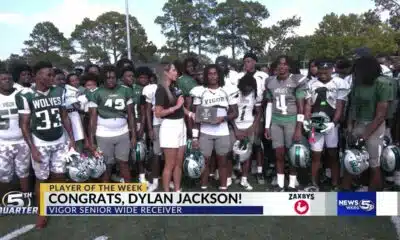(The Center Square) – Boeing earned a contract to build the U.S. Air Force’s top air dominance fighter, the F-47 and the service has plenty of options to base operational squadrons both in the U.S. and overseas.
The sixth-generation aircraft is intended to replace the Air Force’s existing top fighter, the Lockheed Martin F-22 Raptor and will work with uncrewed aerial vehicles.
The service says the aircraft will fly by the end of the decade.
“Compared to the F-22, the F-47 will cost less and be more adaptable to future threats – and we will have more of the F-47s in our inventory,” Chief of Staff of the Air Force Gen. David Allvin said in a statement. “The F-47 will have significantly longer range, more advanced stealth, be more sustainable, supportable, and have higher availability than our fifth-generation fighters. This platform is designed with a ‘built to adapt’ mindset and will take significantly less manpower and infrastructure to deploy.”
The need for the F-47 was crystalized as potential foe China has already flown a pair of tailless sixth generation prototypes and already has two fifth generation fighters, the Chengdu J-20 and the smaller Shenyang J-35, in service.
Where the F-47s would be based once they enter service is up for debate.
The F-22 equips operational squadrons at Joint Base Langley-Eustis in Virginia, Joint Base Elmendorf–Richardson in Alaska and Joint Base Pearl Harbor-Hickam in Hawaii.
There would be more wings equipped with the Air Force’s premier fighter, but the administration of then-President Barack Obama fought and won a battle in 2009 to stop production of the jet at 187 airframes, far less than the 400 the service originally wanted.
Obama said with the wars in Iraq and Afghanistan, the Pentagon couldn’t afford more of the fighters and wanted the service to pivot to the less expensive F-35 Lightning II, also built by Lockheed Martin.
The final Raptor left Lockheed’s Marietta plant in Georgia in December 2011.
U.S. Air Force Maj. Josh Gunderson, F-22 Raptor Demonstration Team commander and pilot, takes off during an aerial demonstration at Joint Base Langley-Eustis, Va., March 30, 2020.
The 1st Fighter Wing in Virginia operates half of the service’s 187 F-22s, divided between three squadrons (the 27th Fighter Squadron, 71st Fighter Squadron and the 94th Fighter Squadron).
The wing was the first operational wing to field the F-15 Eagle (1976) and the F-22 Raptor (2005), so it could be the first unit to receive the new F-47.
The F-22 also equips two squadrons with the 3rd Wing in Alaska and a single squadron, the 19th Fighter Squadron, in Hawaii.
Each combat ready F-22 squadron fields about 24 aircraft.
Langley-Eustis has the Air Force’s lone F-22 training squadron, which provides conversion training for pilots both fresh from flight training and others transitioning to a new aircraft. This squadron was moved from Tyndall Air Force Base in Florida after Hurricane Michael devastated northwest Florida in 2019.
F-22s are also used for testing at Edwards Air Force Base and as part of the 433rd Weapons Squadron, which conducts the F-22 Fighter Weapons School and develops tactics for the aircraft.
If the new F-47 fighter replaces F-22s one-for-one and production is extended past the F-22’s 187 airframes, new locations could host the aircraft. One of those could be Eglin Air Force Base in the Florida Panhandle.
The 33rd Fighter Wing was the U.S. Air Force’s top-scoring unit in the 1990 Gulf War with Iraq. Their F-15s shot down 16 Iraqi aircraft, but the unit was transitioned to a training role with the F-35 Lightning in 2009 as the service’s first schoolhouse for the type.
The Air Force now has training squadrons for the F-35 at Luke Air Force Base in Arizona and will have another one with the Oregon National Guard, raising the possibility of the 33rd transitioning to an combat-ready posture.
Tyndall’s 325th Fighter Wing, based only 89 miles east of Eglin, has converted from the F-22 training unit with one training and one active squadron to a three-squadron active wing with F-35s.
Another possibility could be the 18th Wing at Kadena Air Base on Okinawa, which was a long-time F-15 Eagle unit. The wing’s two fighter squadrons are planned to convert from their aging F-15C/D aircraft to the new F-15EX.
The F-15EX is not stealthy and the Air Force says it’ll likely not be able to fly in airspace contested by newer air defense systems, such as the Russian S-500 Prometheus surface to air missile system. The Air Force is buying 104 of these planes, based on Qatar Emiri Air Force’s F-15QA, as a way to supplement the F-22 and equip primarily Air National Guard squadrons responsible for American air defense.
National Guard fighter squadrons in California, Oregon and Louisiana will convert from the F-15C/D Eagle to the F-15EX, while other Eagle operators (the Florida Air National Guard and the Massachusetts Air National Guard) are or are in the process of converting to the F-35.















































